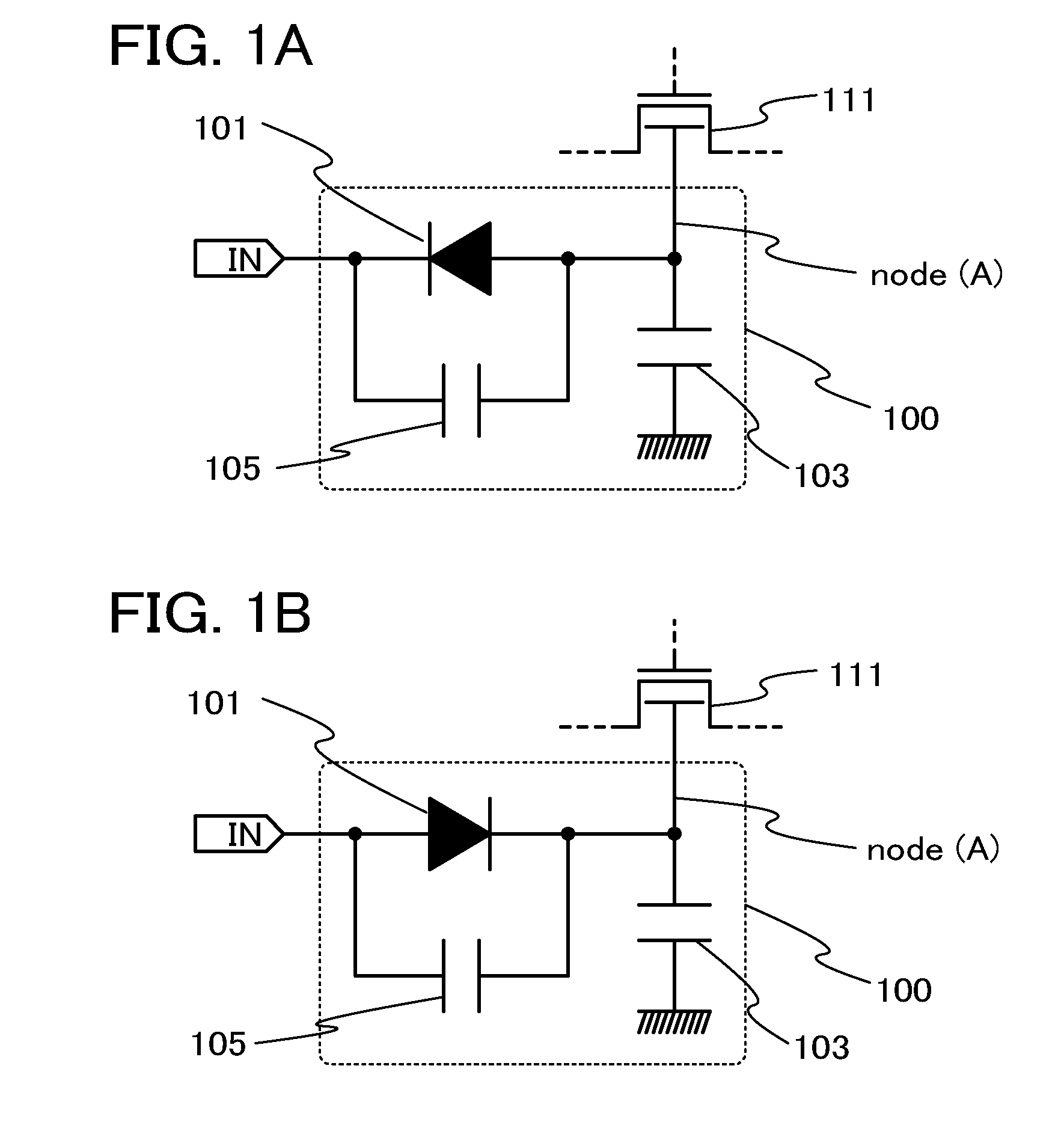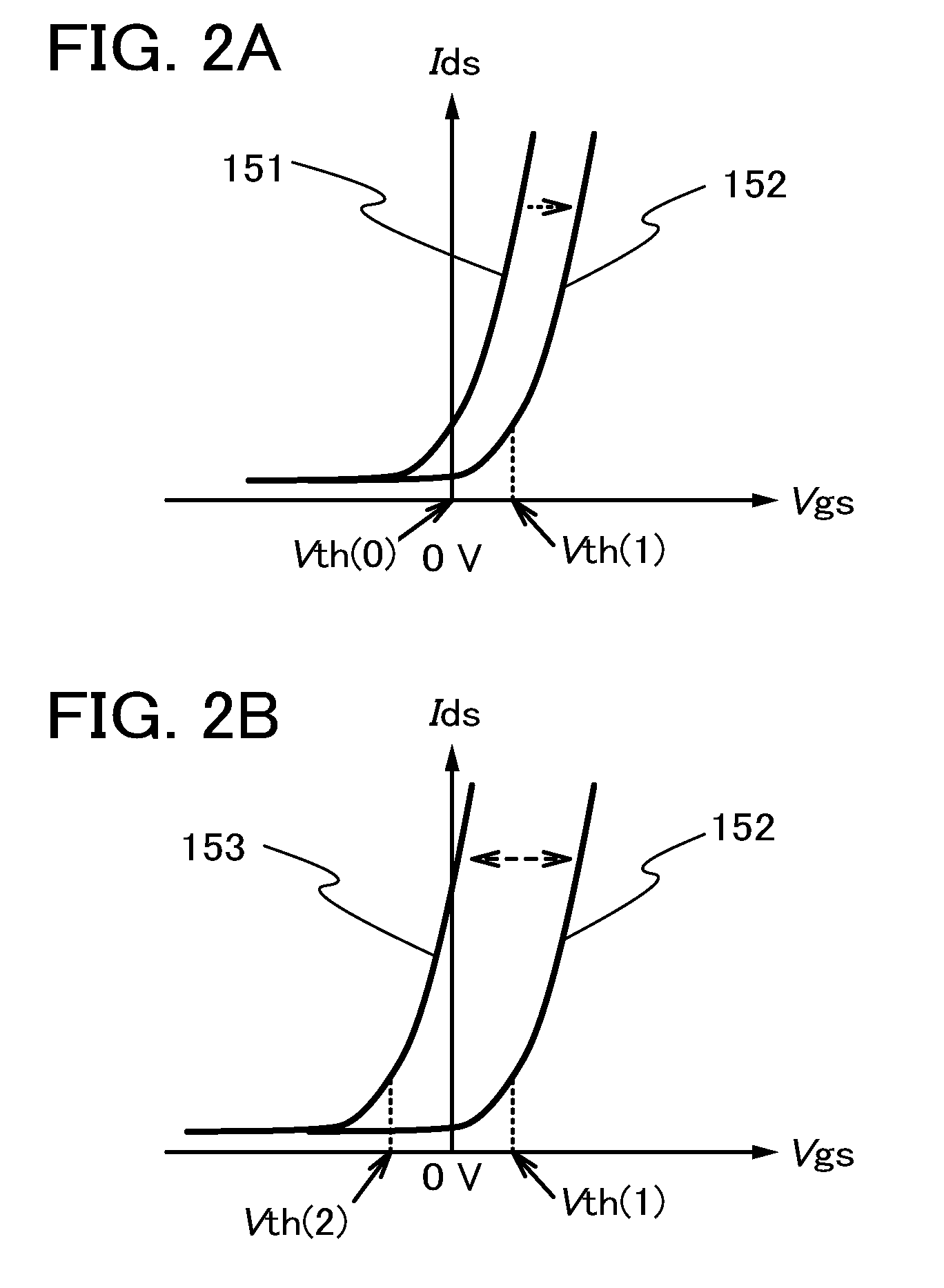Semiconductor circuit, method for driving the same, storage device, register circuit, display device, and electronic device
- Summary
- Abstract
- Description
- Claims
- Application Information
AI Technical Summary
Benefits of technology
Problems solved by technology
Method used
Image
Examples
embodiment 1
[0051]In this embodiment, examples of a semiconductor circuit capable of controlling the threshold voltage of a transistor in the present invention are described with reference to FIGS. 1A and 1B, FIGS. 2A and 2B, and FIGS. 3A and 3B.
[0052]FIG. 1A illustrates a control circuit 100 in this embodiment and a transistor 111 connected to the control circuit 100.
[0053]The transistor 111 includes a back gate (a second gate electrode), and output voltage from the control circuit 100 is input to the back gate. Although an n-channel transistor is used as the transistor 111 in this embodiment, a p-channel transistor can be used.
[0054]The control circuit 100 includes a diode 101, a capacitor 103, and a capacitor 105. An input terminal IN is connected to the control circuit 100. A second electrode of the diode 101 is connected to an input portion, and a first electrode of the diode 101 is connected to a first electrode of the capacitor 103. A second electrode of the capacitor 103 is grounded. Th...
embodiment 2
[0077]In this embodiment, a structure example where the semiconductor circuit capable of controlling the threshold voltage of a transistor in Embodiment 1 is used as a register circuit that is one of storage devices is described with reference to FIGS. 4A and 4B.
[0078]FIG. 4A illustrates a structure example of a 1-bit register circuit to which the control circuit 100 in Embodiment 1 is connected. A register circuit 200 includes a transistor 201, a capacitor 203, and a flip-flop circuit 205. In this embodiment, an n-channel transistor is used as the transistor 201.
[0079]The transistor 201 includes a back gate (a second gate electrode) as in the transistor 111 in Embodiment 1, and output voltage from the control circuit 100 is input to the back gate. An input terminal Sig1 is connected to a first gate electrode of the transistor 201, an input terminal Sig2 is connected to a first electrode of the transistor 201, and the transistor 201 is controlled with input signals from the two inpu...
embodiment 3
[0105]In this embodiment, an example where the semiconductor circuit capable of controlling the threshold voltage of a transistor in Embodiment 1 is used as a storage device whose structure is different from the structure of the storage device in Embodiment 2 is described with reference to FIGS. 5A and 5B.
[0106]FIG. 5A illustrates a structure example of a 1-bit memory cell 250 to which the control circuit 100 in Embodiment 1 is connected. The memory cell 250 includes a transistor 251, a capacitor 253, and a transistor 255. In this embodiment, an n-channel transistor is used as the transistor 251 as in the transistor 201 in Embodiment 2.
[0107]Output voltage from the control circuit 100 is input to a back gate of the transistor 251. An input terminal Sig3 is connected to a first gate electrode of the transistor 251, an input terminal Sig4 is connected to a first electrode of the transistor 251, and the transistor 251 is controlled with control signals from the two input terminals. A s...
PUM
 Login to View More
Login to View More Abstract
Description
Claims
Application Information
 Login to View More
Login to View More - R&D
- Intellectual Property
- Life Sciences
- Materials
- Tech Scout
- Unparalleled Data Quality
- Higher Quality Content
- 60% Fewer Hallucinations
Browse by: Latest US Patents, China's latest patents, Technical Efficacy Thesaurus, Application Domain, Technology Topic, Popular Technical Reports.
© 2025 PatSnap. All rights reserved.Legal|Privacy policy|Modern Slavery Act Transparency Statement|Sitemap|About US| Contact US: help@patsnap.com



